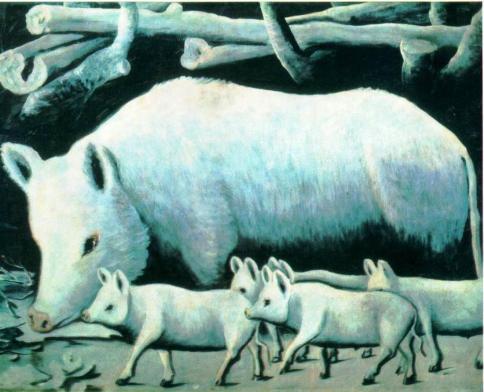
White Sow with Piglets – From Wikimedia Commons – Image by Niko Pirosmani – diary-or-notes.cocolog-nifty.com – Public Domain
Saint Brannock lived in the 6th century and is believed to have traveled from South Wales to North Devon where he settled and built a church. According to one legend, he was supposed to have arrived riding on a donkey. A more imaginative tale tells how he supposedly floated across the Bristol Channel from Wales in a lech which was a stone coffin that Celtic saints were said to take along with them on pilgrimages. At the time of his arrival the village of Braunton as known today did not exist. There was a small pagan settlement set amid forest and scrub land. This small community of small homesteads was centered around what is now Chapel Hill.
Saint Brannock’s Influence
St Brannock gave the community the name Brannock and taught the local people more efficient farming techniques and methods. The people worshiped the pagan gods and spirits of the woods and the rivers and were known to practice child sacrifice and St Brannock set about converting them to Christianity. Despite difficulties he was successful and built the first church in North Devon there.
The White Sow and Seven Suckling Piglets
The site chosen for the new church was Chapel Hill but was beset by problems from the start. No matter how hard they worked during the day when they retired at night they would wake in the morning to find that all their construction of the previous day was inexplicably thrown down. This cycle continued until St Brannock received a visit from an angel that advised him that he should search for a new site. This would be found where a slow flowing stream flowed through a meadow where a white sow would be found suckling seven piglets. Pigs were thought to be a symbol of protection of the church and a mother with seven piglets was deemed very lucky. St Brannock searched and found the place where a white pig was suckling seven piglets and the church was built there, which also the place where today’s parish church of St Brannock stands. The story of the white pig and piglets is depicted in a stained-glass window of the church and on one of its roof bosses. There is also a tradition that he yoked deer and used them to drag wood to be used in the building of the church.
Saint Brannock’s Cow
Another legend tells how St Brannock had a favorite cow that had been stolen and slaughtered by enemies he had made. According to the legend, the cow was butchered and diced up and put in a large pot and hung over a fire to cook. Strangely, neither the pot or the water it contained would become hot enough to cook the meat. When St Brannock became aware of what had happened to his favorite cow he shouted out its name causing it to return to life whole and uninjured by its ordeal. There is a carved pew end in Braunton Church that depicts this story showing the saint with a cow at rest behind him.
Saint Brannock
According to legend, when Brannock died he was buried in St Brannock’s church at Braunton beneath the high altar. There are not many churches that can claim to hold the entire remains of their patron saint so this would be remarkable indeed. To add spice to the legend, during World War ll workmen carrying out work on the high altar found a stone coffin containing bones. The coffin lid was replaced and the coffin returned and the hole made good. Whose bones they were is not known but one naturally thinks of St Brannock and the legend.
© 05/04/2017 zteve t evans
References, Attributions and Further Reading
Copyright April 5th, 2017 zteve t evans

Thanks for introducing me to St. Brannock! Celtic traditions are intriguing